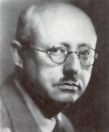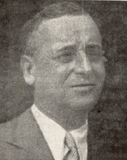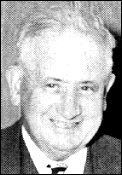

Dr. Carroll Chase
(September 17, 1878 – May 11, 1960) New York, France
Dr. Chase was a world famous expert and plater of the classic stamps of the United States and France. His earliest research, begun around 1900, culminated in his complete plating of the U.S. three-cent 1851-57 issue. This was first published serially in The American Philatelist from January 1923 to July 1926, and then published in book form as The Three-Cents Stamp of the United States 1851-57 Issue (1929), for which he received the Crawford Medal in 1930. Chase later revised the book for a 1942 printing (reprinted in 1975).
Chase moved to France in 1929 and remained there until 1941. While living there, he studied the early stamps and postal history of that country. His most notable work there was the plating of the 25-centime 1871 issue. For these works and many others, he received several awards including the Lindenberg Medal in 1932. With Richard McPherren Cabeen, he was co-author of The First Hundred Years of Territorial Postmarks 1787-1887 (1950).
He was active in
the APS and served as a vice-president in 1915-1917, and as president
in 1920-1922. Chase was one of the original group of philatelists
who signed the Roll of Distinguished Philatelists in 1921. He also
received the Luff Award in 1944 for Distinguished Philatelic Research
and the Lichtenstein Medal in 1954.
Adolph Steeg
(September 19, 1889 – December 31, 1956) Buffalo, New York
Steeg was an active member of organized philately at the national and local level. He was a long-time member and officer of the Buffalo Stamp Club, and was general chairman of the 1940 APS convention in Buffalo, N.Y.
Steeg served the APS for 22 years - as International Secretary (1935-1949), Vice-president (1937-1939) and Treasurer (1949-1956). He rarely missed an APS convention from 1922 until he died.

Rollin E. Flower
(1886 – December 13, 1959) Buffalo, N.Y.
Flower was a strong advocate of national and local philately. A stamp collector since 1898, he participated in the philatelic activities of Buffalo and western New York state. He served the Buffalo Stamp Club in many positions including its presidency. Flower wrote a stamp column in the Buffalo Evening News from 1935 to 1940. He was known for his collections of 19th century U.S. and Civil War patriotics, and his specialized collections of Canada and Newfoundland.
Flower served the
American Philatelic Society in many capacities, including the Board
of Vice-Presidents, 1937-1938, and as President from 1939-1943.
Morris Fortgang
(October 8, 1899 – August 5, 1960) New York City
Fortgang was a specialist and student of the U.S. one-cent 1851-1857 issues. From 1946, he concentrated on that issue and collaborated with Stanley B. Ashbrook on the plating of the difficult plates 3 and 5. Fortgang was instrumental in forming the U.S. 3-cent 1851-57 Unit of the APS (now the U.S. Philatelic Classics Society) and was its first treasurer.
He was Associate
Chairman (with William
W. Hicks) of the “Perforation Centennial” celebrating
the centennial of the issue of the first perforated U.S. stamps
in 1857. Mortimer Neinken
was General Chairman. This event was held at the National Philatelic
Museum in Philadelphia in July 1957. Fortgang presented two papers
published in the Perforation Centennial Book - “The
Centennial of United States Perforated Stamps,” and “The
1-cent Stamp 1851-1857.”
Harry Myron Konwiser
(September 4, 1879 – January 29, 1961) New York City
Konwiser was an outstanding student, writer and expert on U.S. postal history. He wrote extensively on the postal markings of the pre-adhesive period of U.S. philately, and published his United States Stampless Cover Catalog in 1936 (reprinted five times by various publishers between 1938 and 1952).
Konwiser was one of the hobby's most prolific writers. Among his books are Colonial and Revolutionary Posts (1931), Texas Republic Postal System (1933), Konwiser's Check List of Air Mail Covers (1942), American Philatelic Dictionary (1947), and The American Stamp Collector's Dictionary (1949).
Konwiser wrote a column on postmarks in Stamps from June 24, 1933 to September 18, 1954. They were copyrighted and edited by David L. Jarrett, and published as Postal Markings (Harry M. Konwiser) in 1982.

F. Van Dyk MacBride
(1890 – December 25, 1961) New Jersey
MacBride was a foremost expert, collector and writer on Confederate philately. He first showed his philatelic scholarship as a member of “the Four Horsemen” with Dr. Carroll Chase, William B. Sprague and Arthur E. Owen. This group divided up the study of U.S. stamps from the 1847 issue to the 1870-1880 period. McBride chose the 1869 issue for his study and writing, later selling his collection to Congressman E.R. Ackerman.
In the late 1930s, MacBride turned his attention to Confederate philately, joining the Confederate Stamp Alliance. With August Dietz, Sr., and others, he helped increase its membership and prominence. He was an active member, serving in many offices, and was its president at his death.
MacBride was an associate editor of the 1945 edition of the Dietz Confederate Catalog. He and Lawrence L. Shenfield were co-chairmen of the editorial board for the Dietz Confederate Catalog and Handbook, published in 1959. MacBride wrote numerous articles in the Confederate Stamp Album, and its successor, the Confederate Philatelist. “General” MacBride had a noted collection of Civil War valentines. His most famous collection was of Confederate patriotic covers, which received many awards. This collection led to the book, Confederate Patriotic Covers, Including a Check List of All Known Designers (1943, reprinted in 1979). In 1952 he received the Luff Award for Exceptional Contributions to Philately.George Benedict Sloane
(April 3, 1898 – July 15, 1958) New York City
Sloane was a well-known writer, dealer, auctioneer and expert in U.S. stamps. He wrote a weekly column in Stamps magazine from its first issue (September 17, 1932). The total of 1350 columns were collected and published in 1961 as Sloane's Column with George T. Turner as compiler and editor.
During the 1920s and 1930s Sloane held 78 auction sales, mainly of U.S. material. Among the famous collections sold were those of Senator Joseph S. Frelinghuysen (New Jersey), Beverly S. King and Max Johl.
Sloane was advisor to the estates of President Franklin D. Roosevelt and Alfred F. Caspary on the dispositions of their famous collections. He was a noted expert on all U.S. stamps, but had a special interest in U.S. locals and formed an important reference collection of their forgeries, fantasies and imitations.

Louis Henry Barkhausen
(1877 – March 14, 1962) Chicago
Barkhausen was one of the greatest students and collectors of United States postal stationery. He built one of the finest collections of this material ever formed, consisting of covers, cut squares, essays, proofs, postal cards and Western franks.
In 1955 he decided to sell this collection, but before he did so, he removed certain important groups and along with his reference collection, donated them to the Philatelic Foundation where they reside to this day. The auction of the balance of his material by H.R. Harmer, Inc. (1955-56), obtained spectacular results.
Barkhausen used
his collection to publish The Recut Two-cent U.S. Envelope Dies
of the Series of 1904 (1950). He strongly supported the research
work of others, and sponsored the Century Edition of the Thorp-Bartels
Catalog of U.S. Envelopes (1951), using his collection as the
basis for that important work.
Hugh C. Barr
(1878 – June 9, 1960) New York City
Barr was a well-known and widely respected dealer and auctioneer. He entered the stamp business in 1900 and had his first stamp auction in 1931. During the next 25 years he held 166 auction sales.
Among his most noted sales were four parts of the Col. E.H.R. Greeen collection, one of which included the famous Match and Medicine collection of Clarence Eagle. Barr also sold the major part of the philatelic estate of Percy Doane.
Barr was an active
member of the ASDA, and supported its participation in the international
philatelic exhibitions in 1926, 1936 (TIPEX), and 1947 (CIPEX).
After he sold his business in 1956, Barr continued as a philatelic
consultant and advisor.
Hiram Edmund Deats
(May 20, 1870 – March 16, 1963) Flemington, New Jersey
Deats was one of the foremost U.S. collectors of the 19th century. Beginning as a youngster, he built the best collections of U.S. and Confederate States stamps of his time. He sold these and most of his other collections early in the 20th century when he withdrew from organized philately.
Deats was member No. 36 of the American Philatelic Association (now the APS), joining in 1886 at the age of 16. For the next two decades he served the Association in various capacities, including president (1904-1905), and invariably attended the conventions.
He formed an enormous philatelic library, a close second to that formed by John K. Tiffany. In 1952 Deats dispersed his library and duplicates. The major portion went to the Free Library of Philadelphia where much of it still resides. The enormous quantity of duplicates, plus material removed from the Free Library, came on the market over the next two decades in a deluge of mostly 19th century literature unprecedented in philatelic history.
Deats amassed an unsurpassed collection of U.S. revenues. In 1888 he acquired the collection formed by E.B. Sterling. The details about this transaction and later developments are provided in the Sterling biography.
His fabulous revenue collection was used to write An Historical Reference List of the Revenue Stamps of the United States Including the Private Die Proprietary Stamps (1899) (With co-authors George L. Toppan and Alexander Holland.) The book was reprinted in 1979 under its familiar title: The Boston Revenue Book.
Deats signed the Roll of Distinguished Philatelists in 1933.

Henry Chaloner
(December 28, 1874 – November 30, 1963) California
Chaloner was a leading figure in San Francisco Bay area philately for over sixty years. He was called “Dean of Philatelists in the West,” and his collection of California and Western Express covers was world famous. He was a founding member of the Berkeley Philatelic Society in April 1900, and served as its secretary-treasurer for the rest of his life.
Chaloner was Honorary
Life Member Treasurer of the Western Cover Society, and served other
Bay area stamp clubs in their organized activities and exhibitions.
He was a founder of the Philatelic Research Society of Oakland,
and when it was disbanded, its library became the basis for the
Western Philatelic Library in Sunnyvale, Calif.
August A. Dietz, Sr.
(October 19, 1869 – September 26, 1963) Richmond, Virginia
Dietz was a leading student and writer on Confederate States philately. A printer by trade, he edited and published several important journals including The Virginia Philatelist, Southern Philatelist, and New Southern Philatelist.
Dietz's many years of research in Confederate philately led to his well known book The Postal Service of the Confederate States of America (1929). His Dietz Confederate States Catalog and Handbook first appeared in 1931, and was then expanded and reissued in 1937, 1945, and 1959. In 1986, an expanded and augmented edition of this book was published under the title, The New Dietz Confederate States Catalog and Handbook. The Confederate Stamp Alliance (an APS affiliate) purchased the Dietz catalog rights in 2006 and in 2012 published the Confederate States of America Catalog and Handbook of Stamps and Postal History (this is a completely new endeavour building actual contents from the ground up from original source documents rather than simply revising old editions of the catalog. It is also the first digital age edition in color.)
Dietz received
the Lindenberg Medal in 1938. He received the first Luff Award in
1940 for Exceptional Contributions to Philately, and the Lichtenstein
Medal in 1955.
Howard H. Elliott
(April 24, 1875 – November 28, 1963) Boston
Elliott was an active participant in organized philately, notably for the American Philatelic Society and the Royal Philatelic Society of Canada. He was also a student of British North American philately.
For his long service, the Royal Philatelic Society of Canada made him an Honorary Life Member, an honor rarely bestowed on a non-Canadian.
Elliott served the APS in several posts over his 60-year membership (1903-1963). He was the APS treasurer for 28 years, from 1922 to 1949, one of the longest terms of elected office in APS history.





